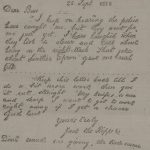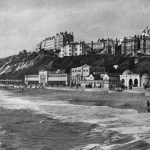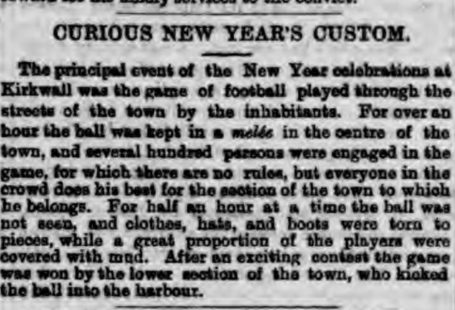Pages from the British Newspaper Archive abound with reports of crimes and their perpetrators, and some of the most intriguing of these are the UK’s unsolved murder cases, where a verdict of ‘murder by person or persons unknown’ has been reached.
In this special blog, we explore five of the most notorious unsolved murders from UK history, ranging from the Thames mystery of the late 1880s, which came to be overshadowed by the Jack the Ripper killings, to the strange death of Charles Walton on Valentine’s Day in 1945, which was to raise suspicions of witchcraft and black magic.
Read on to discover more, and why not try making your own discoveries in our Archive?
Register now and explore The Archive
1. The Thames Torso Murders
In the late 1880s, London was being stalked by the menace of Jack the Ripper. But another killer was operating on the city’s streets, and their identity, like Jack the Ripper’s, was never to be uncovered.
In 1887, the Maryport Advertiser reports how ‘various portions of human remains have been found from to time to time at Rainham, Essex, in the Thames off Waterloo Pier, [and] in the Regent’s Canal, Kentish Town.’ These were judged to belong to a ‘stout, well-nourished female, probably between 25 and 35 years of age,’ whilst her killer was someone ‘who knew the structure of the human frame.’
Londonderry Sentinel | 4 October 1888
This woman was not identified, nor was her cause of death established. Then, just over a year later, next to headlines regarding the Whitechapel Murders, the Londonderry Sentinel reports on ‘the remains found at Westminster.’ Another female dismembered body had been found, and again, ‘nothing was discovered to indicate the cause of death.’ Meanwhile, the victim’s identity once more remained unknown, although the ‘rich glowered underskirt’ that the remains were found with indicated that the ‘unfortunate victim was not one of the poorer classes of society.’
Then in 1889, the Dundee Courier reports how ‘a portion of a woman’s abdomen’ had been ‘found in the Thames at Horsleydown,’ matching ‘the left thigh…which was found just at the same time in the Thames at Battersea.’
Faringdon Advertiser and Vale of White Horse Gazette | 8 June 1889
There were various clues in this third case. ‘A piece of a woman’s skirt, plum coloured with red and white flowers’ was found with the remains at Battersea; whilst a white apron encased those found at Horsleydown, according to the Faringdon Advertiser and Vale of White Horse Gazette.
Furthermore, the Gloucester Citizen reveals how ‘there were four vaccination scars on the upper part of the limb,’ and it was thought that the victim again came from ‘a superior position of life.’ These clues helped, for the first time in this series of Thames mysteries, to establish the victim’s identity. She was supposed to be Elizabeth Jackson, who lived in Chelsea.
Illustrated Police News | 15 June 1889
The South Wales Echo gives the verdict of the inquest into her death, that ‘she had been murdered by some person or persons unknown.’ The ‘Thames Torso Murders’ remains an unsolved murder to this day.
2. The Green Bicycle Case
On the evening of the 5th July last, just before dusk, the body of a young lady was discovered in the middle of the road near Stretton, by a farmer. The body was lying in a pool of blood, and a bicycle was found by her side. At first it was thought she had met with a fatal accident but ultimately it was ascertained that she had been shot through the head.
This report appeared in the pages of the Leicester Daily Post in March 1920, some months after the body of 21-year-old Annie Bella Wright, who was known as Bella, was found in Leicestershire. In a case which frustrated Scotland Yard, it ‘was thought that the tragedy would fall into the limbo of mysteries which are never solved.’
Leicester Daily Post | 6 March 1920
But there was one clue. And that clue revolved around a man and his green bicycle, who had been sighted in the company of Bella. He had been with her as she cycled to visit relatives at Evington, and he had been waiting for her outside when she left. And when that green bicycle was dragged from a canal in March 1920, it led to the arrest of one Ronald Light, a former officer with the Royal Engineers.
The evidence against Light, now a schoolteacher, was compelling. The Leicester Daily Post tells of how Henry Cox, a Leicester cycle repairer, had identified Light ‘from among nine other men as the man who took a green B.S.A. bicycle to his shop.’ And the prosecution launched a stinging attack on Light at the ensuing trial, suggesting that he had been prompted into a rage by Bella rejecting his advances, as well as giving evidence of his movements on that fateful July day:
Between four and four-thirty in the afternoon prisoner was at home for tea, and it was impressed upon him that he must be home at eight-thirty for hot supper. He did not return, however, until ten-thirty, when he was wheeling his bicycle. He told Mary Webb [a domestic at his mother’s house] that he was home late because his bicycle had gone wrong again.
Leicester Daily Post | 6 March 1920
It looked as though Light would be convicted. But as the Nottingham Journal reported, Ronald Light was acquitted, thanks to a ‘brilliant speech’ from his defence counsel Sir Edward Marshall Hall. The defence, using evidence from Light himself, suggested that a shooting accident had occurred resulting in the death of Bella Wright, and that Light, panicking that he had indeed been seen with her, disposed of his tell-tale green bicycle:
I did not give information, because I was absolutely dazed about the whole thing…What I saw in the newspapers was certainly the first intimation to me of the murder…I did not give information because apparently everyone had jumped to the conclusion that the man on the green bicycle had murdered the girl.
The jury accepted this version of events, resulting in the cause of Bella Wright’s death never being determined and therefore it remains another unsolved murder. Mr H Trueman Humphries, according to the Yorkshire Evening Post, had his own theory, but whether this is the truth of what happened to Bella Wright will never be known:
So the theory amounts to this – that a young lad – young, because no one of mature years would take such a risk – seeing the crow perched on the bar of the gate, shot at it from the field. Precisely at that moment Miss Wright, who had been hidden from view by the high hedge, whizzed past the gate, and the shot that killed the bird, and was still rising, killed her.
Leicester Daily Post | 6 March 1920
3. Florence Nightingale Shore – Express Train Crime
In January 1920, nurse Florence Nightingale Shore (goddaughter of Florence Nightingale) was ‘found seriously injured with her head battered in a railway train at Bexhill,’ as reported in the Western Gazette. Shore had been ‘recently demobilised from Queen Alexandra’s Nursing Corps,’ and tragically, the 53-year-old passed away days later from her injuries.
Western Gazette | 16 January 1920
A motive of robbery was considered for this senseless killing, as ‘the lady’s railway ticket and money’ were missing. A couple of weeks later, a man arrested for another crime confessed at Hammersmith Police Station to the murder, but as stated in the Evesham Standard & West Midlands Observer, ‘Investigations show that he was neither in London nor Sussex on the day Miss Shore was killed, and it is probably that he hoped by his confession to be sent to detention as a lunatic, with the possibility of an early discharge.’
At the inquest, suspicions centred on man who had been seen by Miss Shore’s friend, Mabel Rogers, at Victoria Station. He had been seen to enter the same carriage as Miss Shore, and he was described as being ‘about five feet eight, and was from twenty-five to thirty.’
Newcastle Daily Chronicle | 21 January 1920
Henry James Duck, the guard of the train upon which Miss Shore was travelling, saw a suspicious man alight at Lewes. According to the Pall Mall Gazette, Duck ‘saw the man get out of the back portion of the train, and remarked to him: ‘Didn’t they tell you at Victoria to get in the front (Lewes) portion of the train?’ The man’s actions were out of the ordinary, as he had to walk along the footboard to leave the train.
But the man was never found, and the nurse Florence Nightingale Shore’s murder has remained unsolved, meaning that in early 1920 there were ‘at least nine murderers at large’ (Globe, February 1920).
4. The Brighton Trunk Murders
The south coast was again to be home of more killings, which would provide fodder for especially salacious headlines. In 1934 a trunk was discovered at Brighton railway station containing the remains of a woman, and a scrap of paper containing the word ‘Ford,’ which was thought to be the last part of a place name, and was the only tangible clue.
Brighton in 1933 | The Sphere | 10 June 1933
As the Daily Herald reports, Sussex police soon swung into action to establish both the identity of the victim, and of her killer. 40 police set out to ‘comb three Sussex towns,’ in a military style operation covering Brighton, Hove and Portslade. As the Nottingham Journal remarked: ‘it is difficult to believe that the killing, dissecting and disposal could have been done without arousing any suspicion.’
But as with the Thames murders some fifty years before, both victim and murderer remained unidentified. And then, in July 1934, just a month later, another body in a trunk was discovered in Brighton. Her identity was discovered to be that of Violet Saunders, also known as Violette or Violet Kaye, a dancer. And her alleged killer was soon brought into custody, a onetime waiter Toni Mancini, who also went by the name Jack Notyre.
Hull Daily Mail | 17 July 1934
Brighton, then full of summer holiday makers, was swept into a frenzy by this case:
Crowds of holiday-makers, many of them in bathing costumes, gathered to see Mancini arrive at Brighton Town Hall, and amazing scenes were witnessed as they fought to catch a glimpse of him.
But the case against Mancini, like the one against Ronald Light, would not stick. Mancini admitted to finding Violet dead, but given his criminal record, he thought that the police would be sure to arrest him. So he disposed of her body in the trunk. The defence put forward that Violet had died accidentally due to her abuse of morphine, or that she had been killed by somebody else.
The presiding judge, Mr Justice Branson, instructed the jury as follows: ‘If you are not satisfied that she died from the blow upon her head then I think you should immediately acquit this prisoner’ (Gloucestershire Echo, December 1934).
Hull Daily Mail | 17 July 1934
Mancini was duly acquitted, whilst the first of the Brighton trunk murders, deemed not to be connected to the death of Violet Kaye, remained yet another unsolved murder.
5. Witchcraft in Warwickshire – the Death of Charles Walton
Our final UK unsolved murder occurred on Valentine’s Day, 1945. The next day, the Belfast Telegraph gave the following report:
A hedgecutter was found dead early to-day in a ditch near Stratford-on-Avon with his head almost severed from his body. The man was after identified as Charles Walton (74), who lived with his niece at Upper Quinton and for whom search was made when he failed to return home on Wednesday night.
Belfast Telegraph | 15 February 1945
Elderly hedge-cutter Charles Walton had been found dead in a lonely spot near Meon Hill, near to Lower Quinton, Warwickshire. The Warwick and Warwickshire Advertiser carried the report of Home Office pathologist Professer J.M. Webster, who determined that ‘Walton died from shock and haemorrhage due to grave injuries caused by a cutting weapon and a stabbing weapon.’
Scotland Yard were soon brought in to help solve the horrible crime. But, as investigating officer Fabian was to find, this was not to be a simple case.
Birmingham Daily Post | 19 August 1968
First, there was the apparent reluctance of the local villagers to speak. Fabian relayed this in his 1950 book, which was quoted in The Tewkesbury Register and Agricultural Gazette:
There were lowered eyes, reluctance to speak except to talk of bad crops – a heifer that died in the ditch. But what had they to do with Charles Walton? Nobody would say….Cottage doors were shut in our faces and even the most innocent witnesses seemed unable to meet our eyes. Some became ill after we spoke to them.
And then, there were the associations with witchcraft. Fabian was pointed to local history books which recounted historic killings in the same area; in 1875 a young man killed an elderly woman named Ann Turner, as he believed that she had bewitched him, whilst John Haywood had killed a woman with a pitchfork as he set out to kill ‘all the 16 witches in Long Compton.’
A suspect was found in the shape of an Italian from the nearby prisoner of war camp. He had been seen with blood on him, but it was later determined to be rabbit’s blood. And despite the taking of 4,000 statements, Fabian was not able to catch the killer.
Meon Hill | Illustrated London News | 2 November 1981
And so, a swirl of innuendo and mystery surrounded the case. An Illustrated London News article entitled ‘Haunted Warwickshire’ relays how witchcraft authority Dr Margaret Murray ‘declared herself 95 per cent certain that Charles Walton had been killed as a sacrifice by people who adhered to an ancient idea of the victim’s blood revivifying the earth.’
The same piece recounts how a Birmingham woman and ex-member of a satanic cult told the police how the death of Charles Walton had been a black-magic killing. Ron Harding, in a 1975 article for the Coventry Evening Telegraph, 30 years after the murder, demands that ‘it’s time to close the file and leave Lower Quinton in peace.’
He defends the villagers, and attacks the improbable rumours:
Witchcraft or no, it would not be possible to do justice here to the mass of misrepresentation, myth and malevolence that have been stirred into a manmade mixture in which compassion only appears as a trace element. A blanket of silence is one thing – conspiracy of silence another. I wouldn’t expect decent country folk to talk with relish about anything so horribly unsavoury that it seems like only yesterday.
Whether fuelled by witchcraft, or something more mundane Charles Walton’s murder is still unsolved to this day, and ‘Meon Hill keeps its secrets.’




















